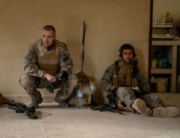

A woman feeding her goats, a small boy asking to go shopping with his father—these moments of domesticity at the Yazidi Home Center in northern Syria belie an undercurrent of trauma that runs throughout this eye-opening and often riveting documentary of dangerous on-the-ground activism.
In 2014, the Islamic State, or ISIS, attacked the Yazidi community, a Kurdish ethnic minority who have their own religion, in northern Iraq’s Sinjar province. Thousands of Yazidi women and girls were captured, forced into marriages, raped, and trafficked as sex slaves, sabaya in Arabic.
Five years later, Kurdish director Hogir Hirori’s camera observes Mahmud, a volunteer at the compound, at work, often in contact with a team of Yazidi women who, armed only with cell phones, have infiltrated the Al Hol camp in northern Syria, where reportedly 73,000 supporters of ISIS are held, guarded by Kurdish forces in an area controlled by the Democratic Syrian Forces. According to a news report overheard in the documentary, Al Hol ranks as the most dangerous camp in the Middle East. With the aid of other Yazidi activists like Mahmud, the infiltrators help spring women out of the camp. From there, the former captives are taken to the center where they recuperate under the care of Siham and Zahra, Mahmud’s wife and mother, respectively, before their return home. (Hirori, who also filmed, co-produced, and edited the film, is from Mahmud’s hometown in Iraq.)
Without a doubt, the nighttime rescue missions into the camp accelerate the film’s pulse, whether Mahmud and his cohorts locate a woman or leave empty-handed. (Yes, he carries a gun.) Among those liberated during the multiple missions is a seven-year-old girl who was an infant when she was kidnapped. Mahmud also ventures into a prison, where roughly 5,000 ISIS supporters are incarcerated, in search of information.
Even though ISIS has been defeated, its forces still pose a danger as sleeper cells roam the Syrian countryside, including in a village near the Yazidi refuge. A harrowing nighttime high-speed chase, in which Mahmud’s jeep is shot at and chased by another vehicle, is interwoven into the narrative as one example of the dangers the Yazidis confront.
Presumably Hirori had to focus his camera on the center for security reasons for all those concerned. Perhaps it goes without saying that it would have been too dangerous to have the women filming in the camp with hidden cameras. (Hirori was his own one-man crew.) Yet the viewers’ attention may be divided between the day-to-day rehabilitative work of the shelter and the actions of the undercover agents/activists, many of whom were former sabayas who have returned to Syria and chosen to don the black niqab, the full body covering enforced by ISIS. This allows them to blend into the camp’s population to trace and save other Yazidis. One of the most arresting shots is from an infiltrator’s point of view of camp life.
Hirori has made a vital and important portrait of a part of the world that sporadically appears in the U.S. news cycle now, as well as a reminder of the long-term ramifications of a region enduring more than a decade of war.
















Leave A Comment